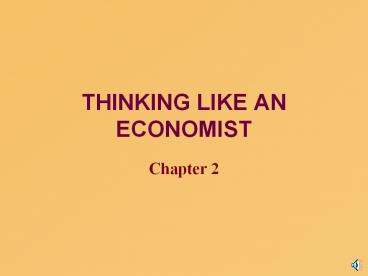THINKING LIKE AN ECONOMIST - PowerPoint PPT Presentation
1 / 26
Title: THINKING LIKE AN ECONOMIST
1
THINKING LIKE AN ECONOMIST
- Chapter 2
2
Economist as Scientist
- Economists try to address their subject with a
scientific objectivity. The essence of science is
the scientific method. - Scientific methods...
- start from crude observation
- then develop a rigorous theory or model that
explains the observed phenomenon - finally test the theory by collecting and
analyzing data from many different sources. - Hence scientific methods include...
- developing abstract models and the analysis of
the modelsdeductive or analytical method - collecting and analyzing data systematically
inductive or empirical method
3
Economic Models
- The purpose of models is to learn about reality
in a simple and intuitive way and not to capture
all the details of reality. - Learning anatomy with plastic models of the human
body - Economists use models, often composed of diagrams
and equations - In simplifying the reality, the role of
assumptions is important. The art in scientific
thinking is deciding which assumptions to make.
4
Our First Model The Circular-Flow Model
- The economy consists of millions of people
engaged in many activities. - The circular-flow model is a simple way to
visually show the economic transactions that
occur between households and firms in the economy.
5
The Circular-Flow Diagram
6
The Circular-Flow Diagram
7
The Circular-Flow Diagram
8
The Circular-Flow Diagram
9
The Circular-Flow Diagram
10
The Circular-Flow Diagram
11
The Circular-Flow Diagram
12
The Circular-Flow Diagram
13
The Circular-Flow Diagram
14
MARKETS
Spending
Revenue
FOR
GOODS AND SERVICES
Firms sell
Goods and
Goods
Households buy
services
and services
bought
sold
FIRMS
HOUSEHOLDS
Produce and sell
Buy and consume
goods and services.
goods and services.
Hire and use factors
Own and sell factors
of production.
of production.
Labor, land,
Inputs for
MARKETS
and capital
production
FOR
FACTORS OF PRODUCTION
Households sell
Income
Wages, rent,
Firms buy
and profit
5
Flow of goods
and services
Figure 2-1
5
Flow of dollars
15
Our Second Model The Production Possibilities
Frontier
- The production possibilities frontier is a graph
showing the various combinations of output that
the economy can possibly produce given the
available factors of production and technology. - By assuming that a given economy produces only
two goods, it shows tradeoffs the economy faces.
16
Linear Production Possibility Curve
- A rancher produces two goods meat and potato
- Hours needed to produce one pound of
- meat is 1 hour
- potato is 8 hours.
- Total working hours 40 hours
17
Amount Produced in 40 hours
Opportunity Cost of 1 Pound of Potato 8 Pound
of Meat
18
Production Possibility Curve of A Rancher
The slope of PPC represents the opportunity cost
of potato
Meat (pounds)
40
A point inside the PPC is inefficient A point on
the PPC is efficient. A point outside the PPC is
infeasible.
B
20
Potatoes (pounds)
2½
0
5
19
Bowed-Out Production Possibility Curve
- Linear PPC reflects constant opportunity cost.
But the opportunity cost of good A in terms of
good B may depend on how much each good the
society is producing. - When the economy is using most of its resources
to make cars, even workers and tools best suited
to making computers are being used to make cars
the opportunity cost of a car will be very large.
20
Figure 2-2
21
The Production Possibilities Frontier
Quantity of
Computers
Produced
4,000
3,000
2,100
2,000
A
Quantity of
700
750
0
1,000
Cars Produced
22
The Production Possibilities Frontier
Quantity of
Computers
Produced
4,000
3,000
2,100
2,000
A
Quantity of
700
750
0
1,000
Cars Produced
23
The Production Possibilities Frontier
Quantity of
Computers
Produced
4,000
3,000
2,100
E
2,000
A
Quantity of
700
750
0
1,000
Cars Produced
24
Figure 2-3
25
Ideas Illustrated by the Production Possibilities
Frontier
- Efficiency
- Tradeoffs
- Opportunity Cost
- Economic Growth
26
Studying Economics with Data
- Time Series, Cross Section, and Panel Data
- Absolute Values versus Rate of Change
- Rate of change (X1-X0)/X0 X1/X0 -1
- The rate of increase in unemployment can fall
even though unemployment is increasing. - Real versus Nominal Values
- real GDP nominal GDP/Price index
- real growthnominal growth-inflation rate
27
Types of Data
28
Omitted Variable Fallacy
- It is very common to use graphs to argue about
how one variable (X) causes another variable (Y). - Such a graphical relationship can often be
deceptive unless we properly control all other
variables (Z) that might also affect Y. - Does the number of cigarette lighters cause risk
of lung cancer?
29
Omitted Variable Fallacy
30
Omitted Variable Fallacy
31
Positive versus Normative Analysis
- Positive statements are statements that describe
the world as it is. - ä Called descriptive analysis
- Normative statements are statements about how the
world should be. - Called prescriptive analysis
32
Positive or Normative ?
- An increase in the minimum wage will cause a
decrease in employment among the least-skilled. - Higher federal budget deficits will cause
interest rates to increase. - The income gains from a higher minimum wage are
worth more than any slight reductions in
employment. - Governments should be allowed to collect from
tobacco companies the costs of treating
smoking-related illnesses.






![get [PDF] Download The Economist PowerPoint PPT Presentation](https://s3.amazonaws.com/images.powershow.com/10056775.th0.jpg?_=20240616091)
























